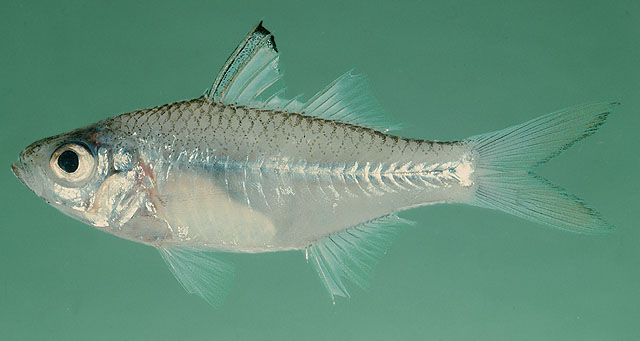|
Ambassis natalensis Gilchrist & Thompson, 1908 Slender glassy |

|
|
photo by
Randall, J.E. |
| Family: | Ambassidae (Asiatic glassfishes) | |||
| Max. size: | 10 cm SL (male/unsexed) | |||
| Environment: | demersal; freshwater; brackish; marine | |||
| Distribution: | Western Indian Ocean: East coast from KwaZulu-Natal south to Algoa Bay in South Africa (Ref. 4318, 7248, 52193). Reported from east Africa (Ref. 4318), including Madagascar (Ref. 4180, 50956) and Mauritius (Ref. 50956). | |||
| Diagnosis: |
Dorsal spines (total): 8-8; Dorsal soft rays (total): 9-11; Anal spines: 3-3; Anal soft rays: 9-11. Diagnosis: Ambassis natalensis has following combination of characters: supraorbital spines 1-4; rostral spine absent; rear margin of preopercle entirely serrate; preopercle ridge smooth except for 1-5 tiny spines at rear corner; interopercle smooth or with 1-4 tiny serrae at angle; two rows of cheek scales; predorsal scales 9-11; lateral line continuous; lower gill rakers 19-22; pectoral-fin rays 14-15; teeth on vomer and palatines in 2-3 rows (Ref. 50956). Description: Dorsal fin with 8 spines and 9-11 soft rays; anal fin with 3 spines and 9-11 soft rays; pectoral fin with 14-15 rays (Ref. 4318, 50956, 52193). Lateral line usually continuous, with 27-29 scales, several specimens from Mauritius with lateral line interrupted by 2-3 scales on one or both sides; vertical scale rows 28-30; horizontal scale rows 9-10; cheek scale rows 2; predorsal scales 9-11 (Ref. 50956, 52193). Gill rakers 8-10+19-22 (Ref. 4318, 50956). Supraorbital spines 1-4, more numerous in largest specimens; preorbital ridge smooth in smallest specimens, becoming serrate at about 35 mm standard length; preorbital edge with 5-11 serrae; retrorse rostral spine absent; preopercle ridge smooth except for 1-5 small spines at lower rear corner; lower edge of preopercle with 9-18 serrae, rear margin enirely serrate; interopercle with 1-4 minute spines at angle (Ref. 50956). Teeth in villiform bands on vomer, palatines, tongue and jaws; palatine teeth in 2-3 rows in fish over about 20 mm standard length (Ref. 50956). Colouration: Live colouration translucent greenish-brown dorsally, head and abdomen silvery; scales with minute melanophores; membrane between second and fourth dorsal-fin spine dusky, black at tip; black lineations along bases of unpaired fins (Ref. 50956). |
|||
| Biology: | Tolerant of freshwater within a temperature range of 19-27°C (Ref. 4180, 52193, 79840). In summer, it feeds mainly in early evening and late morning while in winter, it feeds both day and night on crustaceans as well as insects (aquatic and terrestrial) and fish (Ref. 7248, 52193). Excellent subject for biological research as it easily thrives in captivity (Ref. 12484). | |||
| IUCN Red List Status: | Least Concern (LC); Date assessed: 12 February 2017 Ref. (130435) | |||
| Threat to humans: | harmless | |||